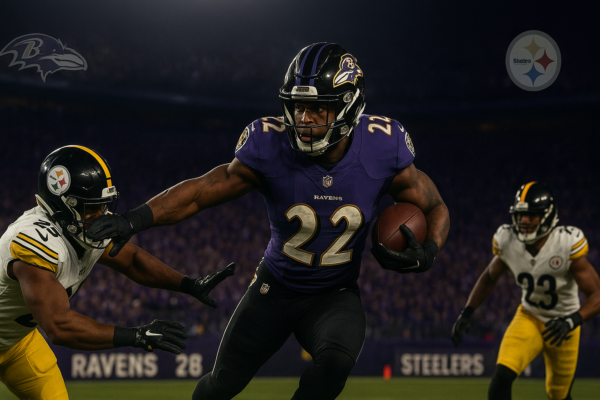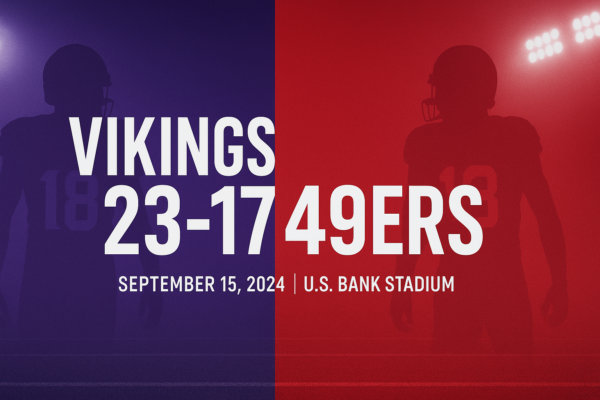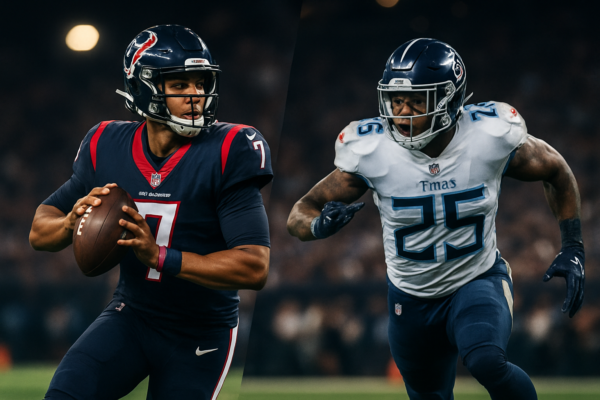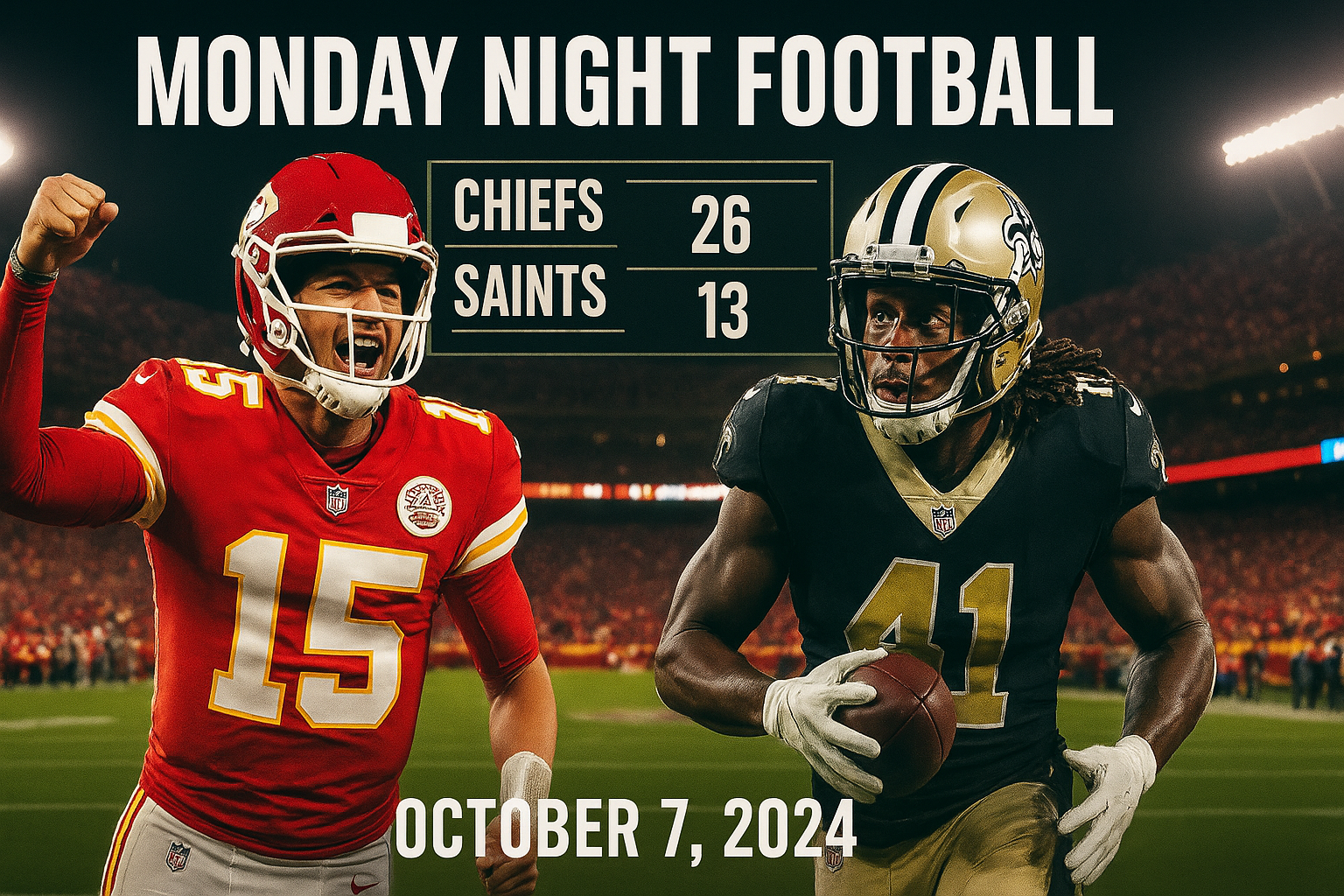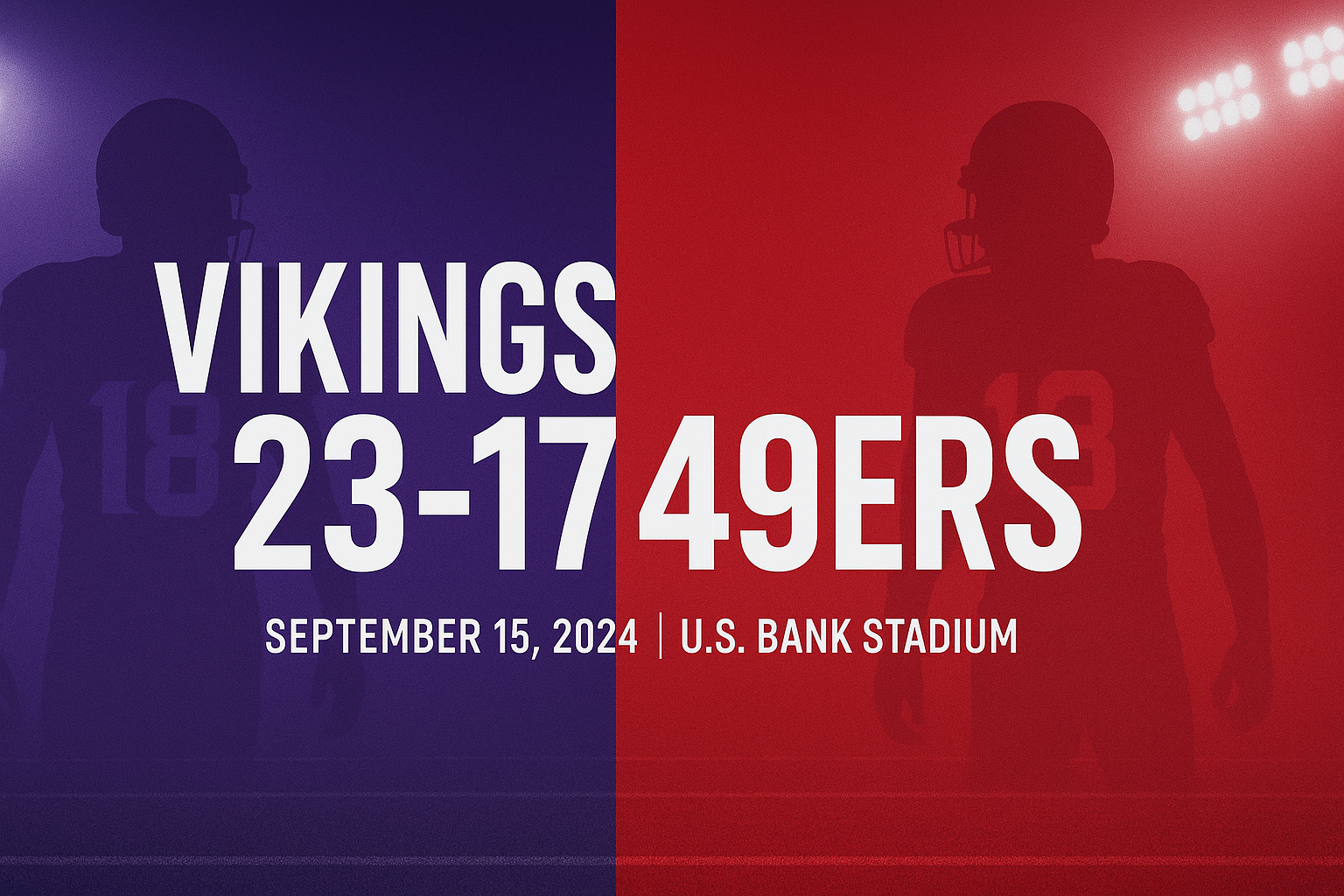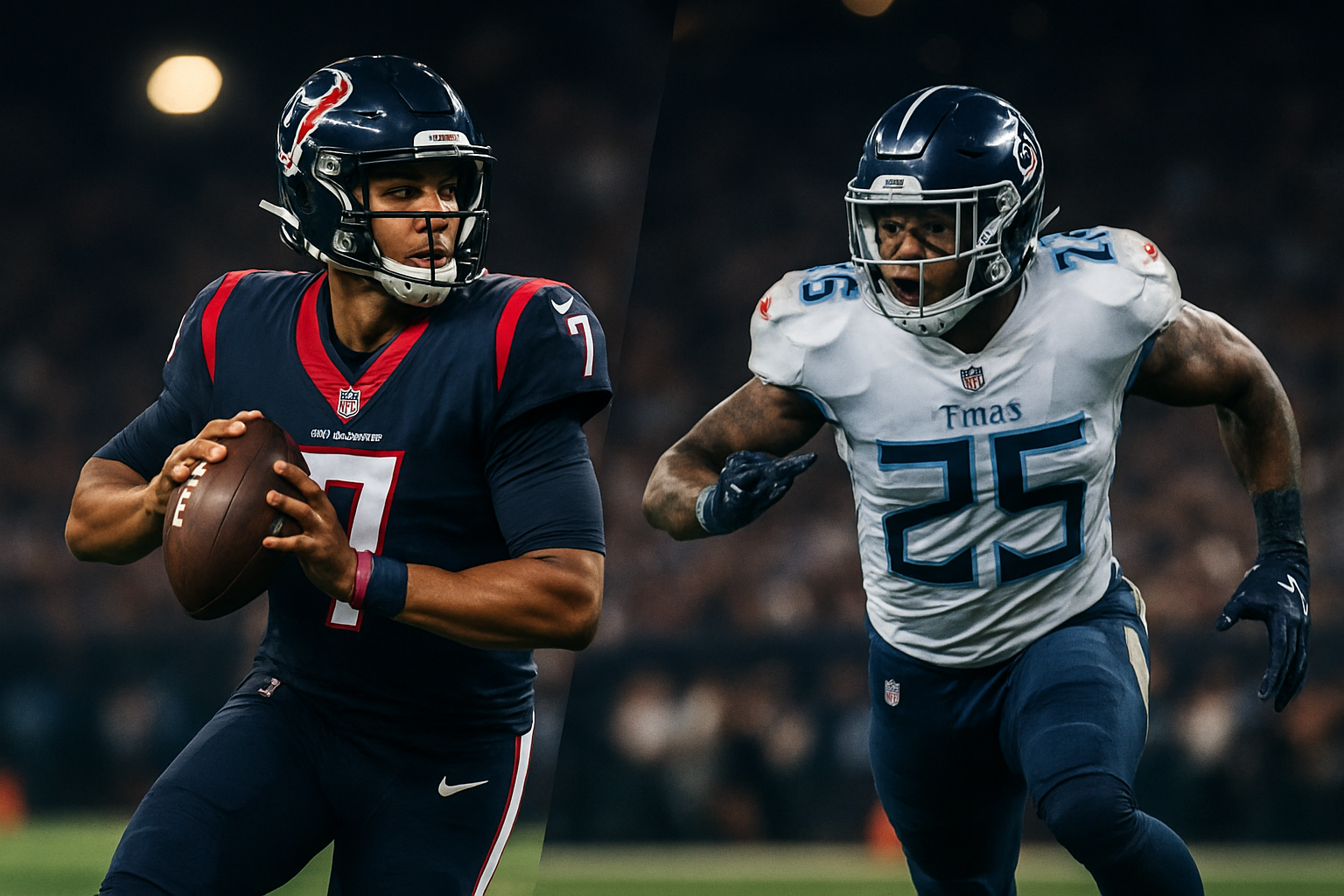
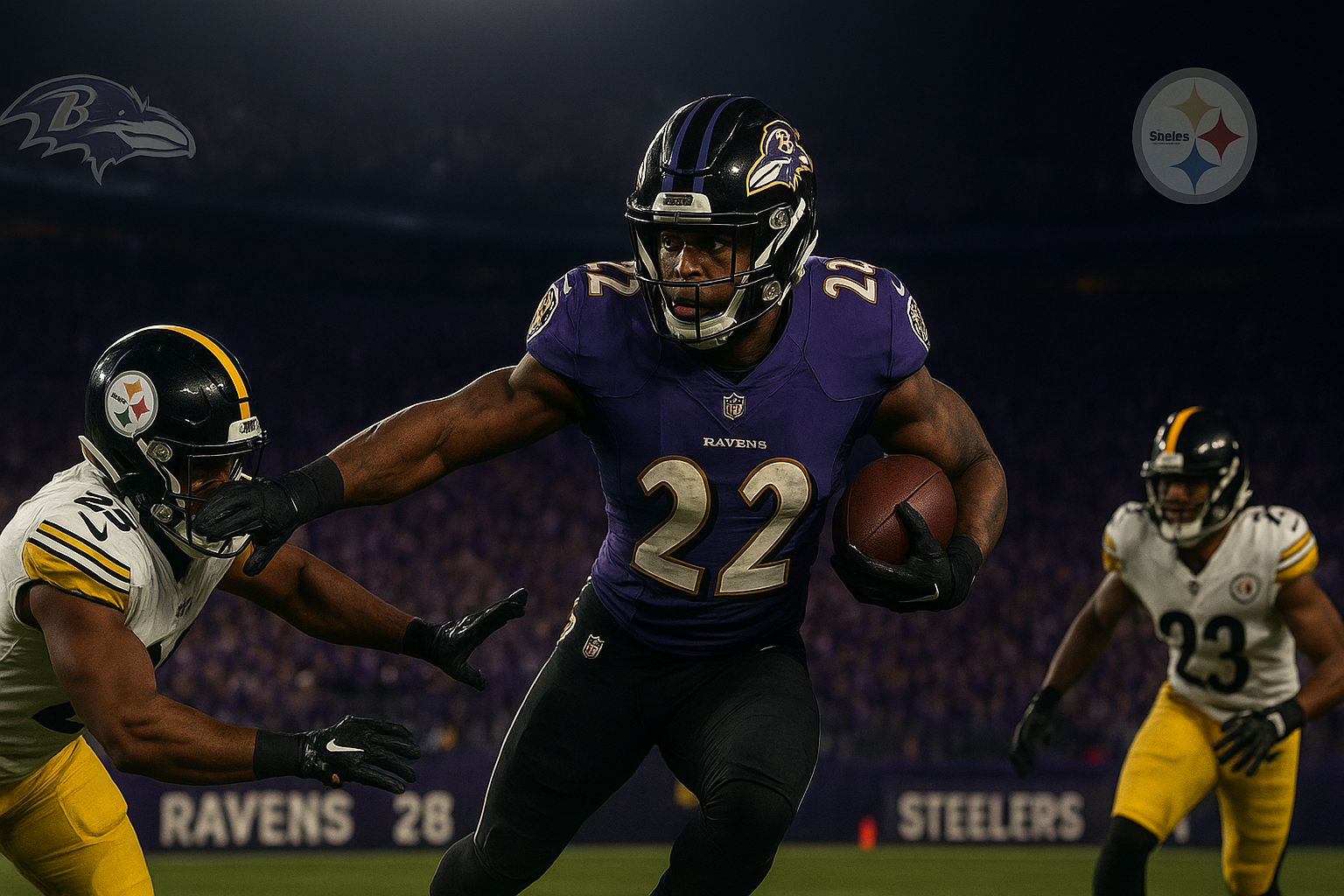
Baltimore Ravens vs Pittsburgh Steelers Match Player Stats (Jan 11, 2025)
Baltimore’s 28-14 dismantling of Pittsburgh on January 11, 2025 proved what happens when an offensive line creates running lanes and a defense refuses to break. The Ravens advanced to the AFC Divisional Round with a performance built on 299 rushing yards and a first-half shutout that left the Steelers searching for answers they never found.
Quick Facts
Final Score: Ravens 28, Steelers 14
Location: M&T Bank Stadium, Baltimore, MD
Attendance: 70,546
Date: January 11, 2025 (AFC Wild Card)
Game Changers:
- Derrick Henry: 186 rushing yards, 2 TDs (franchise playoff record)
- Lamar Jackson: 76.2% completion rate, 2 passing TDs, 81 rushing yards
- Ravens defense: First playoff shutout half since Super Bowl XXXV
- Pittsburgh’s rush defense: Allowed most yards in franchise playoff history (299)
Table of Contents
Three Plays That Decided the Game
Baltimore controlled this Wild Card matchup from the opening kickoff, but three specific moments sealed Pittsburgh’s fate.
Opening Drive Statement (Q1, 4:45)
Baltimore’s 13-play, 95-yard march consumed 7:13 and ended with Jackson’s 15-yard touchdown pass to Rashod Bateman on 3rd-and-13. The physical drive featured Henry’s 34-yard run where he stiff-armed Minkah Fitzpatrick to the ground. Pittsburgh’s defense never established the aggressive tone Mike Tomlin wanted, setting the pattern for 60 minutes.
Justice Hill’s Pre-Halftime Dagger (Q2, 0:02)
With 11 seconds remaining and Baltimore ahead 14-0, Jackson scrambled under pressure as Pittsburgh defenders swarmed. He kept the play alive while running toward the sideline, then dumped a pass to Justice Hill in the flat. Hill walked into the end zone with 2 seconds left. The 21-0 halftime lead deflated Pittsburgh’s sideline and gave Baltimore complete control.
Henry’s Knockout Punch (Q3, 5:49)
After Pittsburgh cut the deficit to 21-14 with back-to-back third quarter touchdowns, momentum appeared to shift. Henry destroyed that hope immediately. He took a handoff up the middle, hit the hole at full speed, and raced 44 yards for a touchdown. The score restored a three-score lead and ended any realistic comeback hopes.
Ravens vs Steelers Game Flow: First Half Dominance
Baltimore grabbed a 21-0 halftime advantage and controlled possession for nearly two-thirds of the game. The Steelers scored twice in the third quarter to cut the deficit to 28-14, but Baltimore’s methodical offense kept Pittsburgh’s attack on the sideline for most of the night.
| Team Statistics | Ravens | Steelers |
|---|---|---|
| Final Score | 28 | 14 |
| Total Yards | 464 | 280 |
| First Downs | 29 | 11 |
| Time of Possession | 39:33 | 20:27 |
| Third Down Efficiency | 10-15 (66.7%) | 5-11 (45.5%) |
| Fourth Down Conversions | 0-0 | 0-1 |
| Penalties-Yards | 3-14 | 7-41 |
Baltimore ran 72 offensive plays to Pittsburgh’s 45. That 27-play advantage created more scoring opportunities and kept the Ravens defense fresh throughout four quarters. The time of possession disparity meant Pittsburgh’s defense spent nearly 40 minutes on the field, wearing down against Baltimore’s physical running attack.
Lamar Jackson: Career-Best Playoff Performance
Jackson delivered his highest-graded playoff game ever according to Pro Football Focus, earning a 92.9 mark. His efficiency eliminated questions about postseason execution that have followed him throughout his career.
| Lamar Jackson Performance | Numbers |
|---|---|
| Completions-Attempts | 16-21 |
| Completion Percentage | 76.2% |
| Passing Yards | 175 |
| Passing Touchdowns | 2 |
| Interceptions | 0 |
| Passer Rating | 132.0 |
| Rushing Attempts | 15 |
| Rushing Yards | 81 |
| Yards Per Carry | 5.4 |
| Rushing Touchdowns | 0 |
| QBR | 82.4 |
| Times Sacked | 1 |
Next Gen Stats credited Jackson with a +16.3% Completion Percentage Over Expected. This means he completed 16% more passes than the average quarterback would have given the difficulty of his throws. His deep ball accuracy and intermediate touch kept Pittsburgh’s defense honest even while Henry dominated on the ground.
Jackson’s 15-yard touchdown strike to Rashod Bateman on 3rd-and-13 came on Baltimore’s opening drive. The throw required perfect timing and placement, hitting Bateman in stride as he crossed the goal line. That early score established Jackson’s command of the offense.
His scramble before halftime became the signature moment. With 11 seconds left and defenders closing, Jackson kept the play alive while moving toward the sideline. He eventually found Justice Hill for a 5-yard touchdown with 2 seconds remaining. Ravens coach John Harbaugh described his thought process during the play in his postgame press conference: “The clock was going a little faster for me in my mind. I’m like, ‘Throw that thing away.’ He threw it, it was a touchdown.”
Jackson averaged 3.02 seconds per throw while facing 9 total pressures from Pittsburgh’s defense. His mobility and quick decision-making neutralized the Steelers pass rush consistently. When protection broke down, Jackson extended plays with his legs, converting several third downs with scrambles.
Derrick Henry: Record-Breaking Power Display
While Jackson orchestrated the attack through the air, Derrick Henry provided the physical punishment that broke Pittsburgh’s defense. The 31-year-old running back set a Ravens franchise record with 186 rushing yards in a playoff game, demolishing Pittsburgh’s defensive front on 26 attempts.
| Derrick Henry Stats | Performance |
|---|---|
| Rushing Attempts | 26 |
| Rushing Yards | 186 |
| Yards Per Carry | 7.2 |
| Rushing Touchdowns | 2 |
| Long Rush | 44 yards |
| Yards After Contact | 157 |
| Missed Tackles Forced | 12 |
| Receptions | 0 |
| Targets | 0 |
Henry’s 7.2 yards per carry destroyed the NFL average of 4.2, meaning every handoff gained an extra three yards compared to typical running backs. His 186 yards broke a 51-year-old record for most rushing yards allowed by Pittsburgh in a playoff game. The Oakland Raiders previously held that mark with 232 yards in 1974.
Henry forced 12 missed tackles on the ground, meaning Pittsburgh defenders whiffed on nearly half his carries. His combination of size at 242 pounds and breakaway speed proved impossible for the Steelers to contain in space.
Three runs defined Henry’s night. His 34-yard burst on Baltimore’s opening drive featured a devastating stiff arm that sent Minkah Fitzpatrick sprawling backward. The 8-yard touchdown run in the second quarter finished a remarkable 13-play drive where Baltimore never attempted a pass, just pure power football that wore down Pittsburgh’s front seven. His 44-yard touchdown in the third quarter, where he reached 20.60 mph per Next Gen Stats, came at the perfect moment to crush Pittsburgh’s brief momentum swing.
Henry and Jackson combined for 267 rushing yards in this AFC Wild Card round game. Only Colin Kaepernick and Frank Gore in the 2012 Divisional Round (300 combined yards) have produced more rushing yardage as a quarterback-running back tandem in playoff history.
Baltimore Passing Attack Adjusts Without Zay Flowers
Zay Flowers missed the game with a knee injury after leading Baltimore with 1,059 receiving yards during the regular season. The passing game adjusted seamlessly, with eight different receivers catching passes and preventing Pittsburgh from keying on any single target.
| Ravens Receivers | Targets | Receptions | Yards | Touchdowns | Long |
|---|---|---|---|---|---|
| Isaiah Likely | 4 | 3 | 53 | 0 | 25 |
| Rashod Bateman | 2 | 2 | 24 | 1 | 15 |
| Mark Andrews | 3 | 2 | 27 | 0 | 20 |
| Nelson Agholor | 1 | 1 | 25 | 0 | 25 |
| Justice Hill | 4 | 4 | 13 | 1 | 7 |
| Tylan Wallace | 2 | 1 | 21 | 0 | 21 |
| Anthony Miller | 3 | 3 | 12 | 0 | 5 |
Bateman’s 15-yard touchdown on 3rd-and-13 opened scoring and gave Baltimore early confidence. Hill’s touchdown before halftime became an instant classic. Likely’s 53 yards led all Ravens receivers, showcasing his ability to find soft spots in zone coverage. The distribution kept Pittsburgh’s secondary guessing all night, unable to focus defensive attention on stopping any particular receiver.
Russell Wilson: Second Half Statistics Masked First Half Struggles
Wilson finished 20-of-29 for 270 yards, two touchdowns, and zero interceptions with a 121.3 passer rating. Those numbers look respectable until you examine when he produced them.
| Russell Wilson Performance | First Half | Second Half | Total |
|---|---|---|---|
| Completions-Attempts | 7-9 | 13-20 | 20-29 |
| Passing Yards | 44 | 226 | 270 |
| Touchdowns | 0 | 2 | 2 |
| Interceptions | 0 | 0 | 0 |
| Sacks Taken | 2 | 2 | 4 |
Wilson completed just 7 of 9 passes for 44 yards in the first half while Baltimore built a 21-0 lead. His two touchdown throws came in the third quarter after the game was effectively decided. The 30-yard strike to Van Jefferson and 36-yard connection with George Pickens created brief hope before Baltimore answered both times.
Pro Football Focus assigned Wilson an 81.4 grade, his season high. That evaluation seems generous considering Pittsburgh’s offense generated just two first downs before halftime and never threatened to make this a competitive game.
Baltimore’s defense sacked Wilson four times for 19 yards lost. Constant pressure disrupted his timing and forced him into uncomfortable situations throughout the night. Wilson averaged just 2.97 seconds per throw while facing pressure on 34% of his dropbacks.
Pittsburgh Ground Game: Historic Shutdown Performance
The Steelers rushed for 29 yards on 11 carries, averaging 2.6 yards per attempt. Baltimore’s top-ranked run defense, which allowed just 77.7 yards per game during the regular season, erased Pittsburgh’s ground attack completely in this postseason matchup.
| Steelers Rushers | Carries | Yards | Average | Long | Touchdowns |
|---|---|---|---|---|---|
| Najee Harris | 6 | 17 | 2.8 | 5 | 0 |
| Jaylen Warren | 2 | 6 | 3.0 | 4 | 0 |
| Russell Wilson | 3 | 6 | 2.0 | 5 | 0 |
Harris entered as Pittsburgh’s featured back but never found running room. Baltimore’s defensive front won at the point of attack repeatedly, penetrating the backfield and forcing Harris into arm tackles before he could build momentum. The Ravens’ aggressive gap assignments and quick defensive line movement prevented Pittsburgh from establishing any rhythm on the ground.
George Pickens Provides Pittsburgh’s Only Consistent Offense
While Pittsburgh’s offense sputtered for most of the night, George Pickens showcased why evaluators consider him an emerging star. He caught all five targets for 87 yards and a spectacular 36-yard touchdown.
| George Pickens Stats | Performance |
|---|---|
| Targets | 5 |
| Receptions | 5 |
| Receiving Yards | 87 |
| Yards Per Catch | 17.4 |
| Touchdowns | 1 |
| Long Reception | 36 |
His third-quarter touchdown catch featured elite body control. Pickens tracked the deep ball over his shoulder, adjusted to Wilson’s placement, avoided a closing safety, and walked into the end zone untouched. Pittsburgh’s puzzling decision to not target their best receiver until late in the second quarter drew criticism afterward and may have cost them any chance at building early offensive rhythm.
Other Steelers receivers produced modest results against Baltimore’s secondary:
| Steelers Receivers | Receptions | Yards | Touchdowns | Long |
|---|---|---|---|---|
| Najee Harris | 3 | 41 | 0 | 21 |
| Van Jefferson | 2 | 37 | 1 | 30 |
| Mike Williams | 1 | 37 | 0 | 37 |
| Calvin Austin III | 1 | 25 | 0 | 25 |
| Jaylen Warren | 4 | 19 | 0 | 7 |
| Pat Freiermuth | 3 | 15 | 0 | 9 |
Ravens Defense Creates Historic First-Half Shutout
Complete First Half Dominance
Baltimore’s defense recorded its first playoff shutout half since Super Bowl XXXV. The unit allowed 60 total yards and two first downs before halftime, completely stifling Pittsburgh’s offensive schemes.
Nnamdi Madubuike’s Pressure Campaign
Madubuike destroyed Pittsburgh’s third-quarter comeback attempt when it mattered most. With the Steelers driving after cutting the deficit to 21-14, Madubuike batted a Wilson pass at the line of scrimmage. Two plays later, he recorded a third-down sack that forced a punt. His pressure disrupted Pittsburgh’s offensive rhythm consistently throughout the night.
Pass Rush Effectiveness
| Ravens Defense Leaders | Tackles | Solo | Sacks | TFL | QB Hits |
|---|---|---|---|---|---|
| Ar’Darius Washington | 7 | 5 | 0 | 0 | 0 |
| Roquan Smith | 5 | 3 | 0 | 0 | 0 |
| Nnamdi Madubuike | 4 | 3 | 2 | 1 | 1 |
| Marlon Humphrey | 4 | 2 | 0 | 0 | 1 |
| Malik Harrison | 4 | 2 | 0 | 0 | 0 |
| Brandon Stephens | 4 | 1 | 0 | 0 | 0 |
Odafe Oweh added another sack and generated five total pressures according to Pro Football Focus, earning a 79.6 grade. Baltimore’s pass rush kept Wilson uncomfortable all night, recording four sacks total and forcing quick throws that prevented Pittsburgh from attacking downfield effectively.
Steelers Defense Surrenders Historic Rushing Performance
Pittsburgh surrendered 299 rushing yards, the most in franchise playoff history. That single number explains the season-ending defeat better than any other statistic.
| Steelers Defense Leaders | Tackles | Solo | Sacks | TFL | QB Hits |
|---|---|---|---|---|---|
| Elandon Roberts | 14 | 7 | 0 | 0 | 0 |
| Patrick Queen | 10 | 4 | 0 | 1 | 0 |
| Cameron Heyward | 10 | 3 | 0 | 2 | 0 |
| Minkah Fitzpatrick | 9 | 5 | 0 | 0 | 0 |
| Joey Porter Jr. | 6 | 6 | 0 | 0 | 0 |
| Payton Wilson | 6 | 3 | 0 | 1 | 0 |
Fitzpatrick recorded a 41.5 Pro Football Focus grade, his worst performance of the season. He missed two tackles, including Henry’s opening stiff arm that established Baltimore’s physical dominance and set the tone for the entire night. Queen, facing his former team, struggled to a 45.1 overall grade and 41.9 run-defense mark after taking poor pursuit angles repeatedly against both Henry and Jackson.
The defensive line couldn’t hold up against Baltimore’s physical offensive front. Larry Ogunjobi (49.2 PFF grade) and Montravius Adams (33.6 grade) lost consistently at the point of attack, allowing Baltimore’s running backs to hit the second level with speed.
T.J. Watt finished with zero tackles and zero sacks in his worst playoff performance. Roger Rosengarten neutralized Pittsburgh’s defensive star throughout the night. Pro Football Focus charged Rosengarten with five pressures, but Jackson’s mobility and Baltimore’s quick-hitting designs prevented those pressures from becoming impactful plays.
Offensive Line Performance: Tyler Linderbaum’s Dominance
Baltimore’s offensive line created massive running lanes throughout this division rivalry playoff game. Center Tyler Linderbaum earned an 86.5 Pro Football Focus grade while consistently winning his matchup against Pro Bowl defensive tackle Cameron Heyward.
The unit averaged 6.0 yards per carry on 50 rushing attempts. Every handoff moved the chains halfway to a first down. Henry and Jackson both broke multiple tackles while hitting the second level with speed. The offensive line’s ability to create movement at the point of attack and sustain blocks at the second level allowed both runners to operate with space.
Coach Harbaugh called it a “signature game” for the offensive line against one of the league’s most physical defensive fronts. The performance validated Baltimore’s offseason investment in building a line capable of imposing their will in January football.
Baltimore Offensive Strategy: Using Jackson’s Legs to Open Lanes
Offensive coordinator Todd Monken built Baltimore’s approach around one core concept: use Jackson’s running threat to create lanes for Henry. The constant threat of designed quarterback runs froze linebackers and created hesitation that Henry exploited repeatedly.
Baltimore used pre-snap motion on 63.9% of plays throughout this Wild Card Saturday matchup. The direct snap to Henry while Jackson motioned across drew three Pittsburgh defenders, creating a 34-yard gain. A 15-yard jet sweep to Steven Sims stretched the defense horizontally, setting up Henry’s 44-yard touchdown up the middle on the next play.
The 13-play, all-run touchdown drive in the second quarter embodied Baltimore’s commitment to physical football. No passes, just 13 consecutive runs that moved the ball 85 yards and consumed nearly eight minutes. Pittsburgh couldn’t stop it, couldn’t slow it, couldn’t recover. That drive broke the Steelers’ will and turned a competitive game into a rout.
The Ravens ran play-action just three times because designed quarterback runs served the same purpose, freezing linebackers and creating hesitation. Steelers coach Mike Tomlin admitted postgame: “We never really found a fluid answer all day.”
Playoff History: Pittsburgh’s Drought Extends to Six Games
This loss marked Pittsburgh’s sixth consecutive playoff defeat. The streak dates back to their last postseason win following the 2016 season when they defeated Kansas City 18-16 on January 15, 2017. The team finished on a five-game losing streak, with two losses coming in Baltimore during that span.
Baltimore improved to 3-2 against Pittsburgh in playoff meetings. The Steelers still lead the all-time postseason series 3-2. Baltimore punched their ticket to the AFC Divisional Round to face either Houston or Buffalo depending on Sunday’s results.
The offensive blueprint Baltimore established here became central to their 2025 regular season approach. The Jackson-Henry rushing combination continued producing elite numbers throughout the year. Their Week 2 meeting with Buffalo in September showed both the ceiling and limitations of this strategy, as they rushed for 245 yards but couldn’t protect a fourth-quarter lead in a dramatic 41-40 loss at Highmark Stadium.
Advanced Performance Metrics and Next Gen Stats
Next Gen Stats provided deeper performance insights that explained Baltimore’s dominance beyond basic box score numbers. Henry’s 157 rushing yards after contact ranked third among all players in a single game during the 2024 season. He forced 12 missed tackles on the ground, combining power with surprising elusiveness for a 242-pound back.
Jackson’s scramble before halftime showed elite pocket awareness and clock management under pressure. His ability to keep the play alive while managing the remaining time demonstrated processing ability that separates elite quarterbacks from good ones.
Baltimore entered the postseason with the NFL’s second-highest tackling efficiency at 89.2%. The defense allowed the fewest yards after missed tackles league-wide. That fundamental soundness appeared throughout the game, limiting explosive plays and keeping Pittsburgh’s offense predictable.
Turnover Battle and Discipline Advantage
Both teams finished with zero turnovers in this AFC Wild Card round matchup. Baltimore’s ball control offense meant Pittsburgh’s defense spent 39:33 on the field, wearing down as the game progressed. The physical toll of defending 50 rushing attempts showed in the fourth quarter as Pittsburgh’s defensive line created minimal push.
The penalty disparity proved significant. Baltimore committed three penalties for 14 yards. Pittsburgh was flagged seven times for 41 yards. Clean execution in playoff games separates contenders from pretenders, and Baltimore’s discipline stood out against a Pittsburgh team that committed costly infractions at critical moments.
Fourth Quarter Coaching Decisions
Baltimore’s aggressive approach on third downs (10-of-15 conversions) sustained drives and maintained possession advantages. The decision to keep feeding Henry, even with a comfortable lead, showed trust in the game plan and respect for Pittsburgh’s offensive potential with Wilson at quarterback.
Pittsburgh’s conservative choice to punt on 4th-and-inches from their own 28 while trailing 7-0 in the second quarter drew criticism. That decision allowed Baltimore to embark on their game-breaking 13-play touchdown drive, turning a one-score game into a two-score deficit that Pittsburgh never recovered from.
Injury Impact on Game Plan Execution
Playing without Zay Flowers, who led Baltimore with 1,059 receiving yards during the regular season, could have disrupted the passing attack. The offense adjusted seamlessly. Depth at receiver and tight end allowed Jackson to distribute targets effectively, preventing Pittsburgh from loading the box against the run without consequences.
Pittsburgh’s injury to tackle Dan Moore Jr. during the game weakened an offensive line already struggling to protect Wilson and create running lanes. The loss forced backup Calvin Anderson into extended action, and Baltimore’s defensive line exploited the mismatch repeatedly in the second half.
Game Conditions at M&T Bank Stadium
The game kicked off at 8:00 PM EST with a temperature of 32 degrees. Relative humidity measured 54%. Wind speeds reached 12 mph. The outdoor grass surface at M&T Bank Stadium was in excellent condition despite cold temperatures.
Vegas established Baltimore as a 9.5-point favorite. The over/under sat at 43.5 points. The game finished under. Attendance reached 70,546, filling M&T Bank Stadium for Baltimore’s first playoff home game against Pittsburgh in the rivalry’s history.
Complete Statistical Summary
| Category | Ravens | Steelers |
|---|---|---|
| Total Plays | 72 | 45 |
| Total Yards | 464 | 280 |
| Yards Per Play | 6.4 | 6.2 |
| First Downs | 29 | 11 |
| Rushing Attempts | 50 | 11 |
| Rushing Yards | 299 | 29 |
| Yards Per Rush | 6.0 | 2.6 |
| Passing Completions | 16 | 20 |
| Passing Attempts | 21 | 30 |
| Passing Yards | 165 | 251 |
| Third Down Conversions | 10-15 | 5-11 |
| Red Zone Efficiency | 3-4 | 0-0 |
| Penalties | 3-14 | 7-41 |
| Turnovers | 0 | 0 |
| Time of Possession | 39:33 | 20:27 |
Individual Player Grades from Pro Football Focus
Baltimore Ravens
| Tyler Linderbaum (C) | 86.5 |
| Lamar Jackson (QB) | 92.9 |
| Kyle Hamilton (S) | 91.7 |
| Odafe Oweh (OLB) | 79.6 |
Pittsburgh Steelers
| George Pickens (WR) | 86.6 |
| Russell Wilson (QB) | 81.4 |
| Minkah Fitzpatrick (S) | 41.5 |
| Patrick Queen (LB) | 45.1 |
Scoring Timeline Throughout Four Quarters
| Quarter | Time | Scoring Play | Score |
|---|---|---|---|
| 1st | 4:45 | Rashod Bateman 15-yard TD pass from Lamar Jackson (Justin Tucker kick) | BAL 7, PIT 0 |
| 2nd | 4:09 | Derrick Henry 8-yard TD run (Justin Tucker kick) | BAL 14, PIT 0 |
| 2nd | 0:02 | Justice Hill 5-yard TD pass from Lamar Jackson (Justin Tucker kick) | BAL 21, PIT 0 |
| 3rd | 8:05 | Van Jefferson 30-yard TD pass from Russell Wilson (Chris Boswell kick) | BAL 21, PIT 7 |
| 3rd | 5:49 | Derrick Henry 44-yard TD run (Justin Tucker kick) | BAL 28, PIT 7 |
| 3rd | 3:24 | George Pickens 36-yard TD pass from Russell Wilson (Chris Boswell kick) | BAL 28, PIT 14 |
Season Context and Championship Implications
This victory advanced Baltimore to the AFC Divisional Round with momentum and confidence. The performance validated their offseason addition of Henry to complement Jackson’s dual-threat abilities. The combination created matchup problems that even a physical Pittsburgh defense couldn’t solve.
Baltimore’s playoff dominance erased memories of regular season inconsistencies. Just six weeks earlier, the Ravens fell to Philadelphia 24-19 at M&T Bank Stadium despite outgaining the Eagles 372-252 yards, as red zone struggles and special teams breakdowns cost them a crucial game. The playoff win over Pittsburgh showed Baltimore had corrected those issues when it mattered most, converting red zone opportunities and executing in critical moments.
Pittsburgh’s loss extended playoff futility that has frustrated the fanbase for eight years. The franchise hasn’t won a postseason game since defeating Kansas City 18-16 on January 15, 2017. The pattern of reaching the playoffs only to exit immediately became increasingly difficult for ownership and fans to accept.
Baltimore’s approach of physical, clock-controlling football with explosive play potential proved effective against Pittsburgh’s defense. The 299 rushing yards represented a complete philosophical victory for coach John Harbaugh’s vision of January football. Teams that can run the ball and control the clock in cold weather give themselves the best chance to advance deep into the playoffs.
Frequently Asked Questions About Ravens vs Steelers Playoff Game
Who won the Ravens vs Steelers playoff game in January 2025?
Baltimore Ravens defeated Pittsburgh Steelers 28-14 in the AFC Wild Card round on January 11, 2025 at M&T Bank Stadium in Baltimore, Maryland.
How many rushing yards did Derrick Henry have vs Steelers?
Derrick Henry rushed for 186 yards on 26 carries with 2 touchdowns, setting a Ravens franchise playoff record for rushing yards in a single postseason game.
What was Lamar Jackson’s passer rating against Pittsburgh?
Lamar Jackson finished with a 132.0 passer rating, completing 16 of 21 passes (76.2%) for 175 yards and 2 touchdowns with 0 interceptions.
How many total rushing yards did Baltimore have?
Baltimore rushed for 299 total yards, the most ever allowed by Pittsburgh in a playoff game. This broke a 51-year-old record of 232 yards set by the Oakland Raiders in 1974.
What was the halftime score of Ravens vs Steelers?
Baltimore led 21-0 at halftime, marking the first time since Super Bowl XXXV that the Ravens shut out a playoff opponent in the first half.
How many times have the Steelers lost in the playoffs since 2016?
This marked Pittsburgh’s sixth consecutive playoff defeat. The Steelers haven’t won a postseason game since defeating Kansas City 18-16 on January 15, 2017.
Did Russell Wilson play well against the Ravens?
Wilson finished with solid statistics (20-29, 270 yards, 2 TDs), but completed just 7 of 9 passes for 44 yards in the first half when the game was competitive. His production came primarily in the second half after Baltimore had built an insurmountable lead.
How many yards per carry did Derrick Henry average?
Henry averaged 7.2 yards per carry, well above the NFL average of 4.2 yards per attempt. This means every Henry handoff gained approximately three extra yards compared to a typical NFL running back.
Complete game statistics available at Pro Football Reference. Additional reporting from the Baltimore Ravens official recap.

